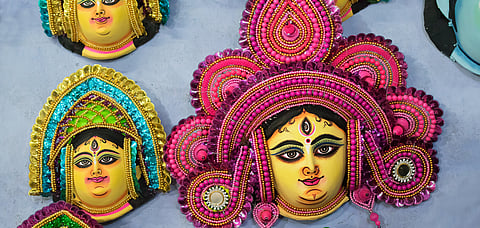
- Destinations
- Experiences
- Stay
- What's new
- Celebrating People
- Responsible Tourism
- CampaignsCampaigns
- SubscribeSubscribe
- Buy Now

At first glance, it was a simple hut made of interwoven leaves, and I would have passed by without another look if it was not for Ankita Toppo who was taking me around the Tribal Culture Centre in Jamshedpur.
"Did you know this simple hut could be a cause of heartbreak for many?", asked a smiling Toppo.
As I took a second look at the hut, she explained it was part of a pre-marital condition followed by the Birhor tribe. A young man who wishes to marry has to build this hut and invite the prospective bride's family. The girl's family will pour a bucket of water over the hut. If the water seeps inside, the marriage is called off. He who cannot build a secure hut cannot be trusted to take care of a family being the reason.
According to the 2011 Census, there are 32 tribes in Jharkhand. According to scholars, tribes in India are often displaced owing to various reasons. The displacement results in the loss of cultural heritage. The Tribal Culture Centre has been established to capture the rich and varied culture of the indigenous tribes of the region. It also runs vocational training programmes for tribal youth besides organising cultural and sports events.
As we took a look around the two-roomed Heritage Hall, strains of mellifluous tribal songs and rhythmic beating of drums reached us. Several tribal groups, who had arrived from nearby villages, were practising their final dance steps. In a couple of hours they would be taking part in the Carnival Parade which would go round the city as part of the Jamshedpur Winterfest 2018.
Since it is impossible to showcase all the 32 tribes, the Centre focused on a few of the representative tribes. Through dioramas, handloom and handicraft, pottery and display boards explaining the origin of the names, the language and script, etc., we learned about tribes such as the Santhal, Ho, Oraon, Munda, Sauria Paharia, Savar, and the Birhor.
In the small lawn just outside the Heritage Hall were busts of famous personalities such as Baba Tilkha Majhi who was the first Santal leader to take up arms against the British way back in the 18th century, Birsa Munda - a patriot and martyr who compelled the British government to promulgate the Chota Nagpur Tenancy Act in 1908, Pandit Raghunath Murmu - philosopher and writer and inventor of Ol Chiki script for writing Santhali, and Pandit Guru Kol Lako Bodra - a much acclaimed leader of the Ho tribe who, among other things, invented the Warang Shiti script to give his tribe a distinct linguistic identity.
The exquisite tribal handicraft, especially the dokra (dhokra) metal craft, and the tribal paintings at the Centre were lovely to look at. Unfortunately, there was no souvenir counter here.
Thankfully, a kind soul directed me to Biponi, a shop managed by Kalamandir Sakshsam SHG Federation, a privately run welfare organisation. The shop serves as a marketing outlet for the tribal craftspeople. There was a wide range of products on display, such as dokra figurines, folk paintings, utility items made of sabai grass, chhau masks, textiles, cane and bamboo furniture, etc.
If you are interested in meeting the artisans, you may visit Amadubi, a small village about 65km from Jamshedpur. Promoted by Kalamandir and managed by Gramin Paryatan Vikas Samity, it has been developed into an artists' village with accommodation for outstation visitors. Set in the middle of scenic countryside, Amadubi offers a pleasant break from the daily routine. Go for walks in the village or among the surrounding Sal forests. Enjoy tribal food. Watch the craftspeople at work. Join the tribal dancers. There is also a small museum offering an insight into the tribal history and culture.
Getting there: Jamshedpur is a convenient base to explore many of the tribal villages of Jharkhand. Jamshedpur is connected by road and rail with the rest of India. Ranchi's Birsa Munda Airport (150km away by road) is the nearest airport. Amadubi is 65km by road from Jamshedpur.
